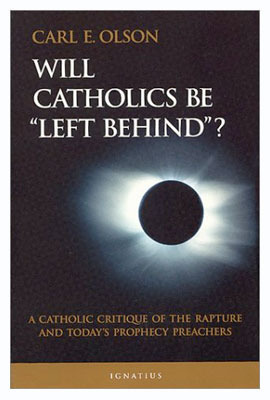A Short History of the "Left Behind" Theology

A Short History of the "Left Behind" Theology | Carl E. Olson | Ignatius Insight
Editor's note: This article is adapted from material in Will Catholics Be "Left Behind"? A Catholic Critique of the Rapture and Today's Prophecy Preachers (Ignatius Press, 2003).
In a January 19, 2003, BBC news article, "Armageddon fiction grips the US," reporter Justin Webb struggled to come to grips with the best-selling Left Behind books (with sales of around 50 million copies at that time), created and co-authored by leading Fundamentalist Tim LaHaye. Webb was apparently bewildered by the topic, and he didn't help matters by misspelling LaHaye's name ("LeHaye").
 Even worse, in seeking to criticize the political message of the novels, he completely missed the theological core of the books. Yet this isn't too surprising, for the theological belief espoused by the Left Behind novels--known as premillennial dispensationalism--is a strange and complex one, with a relatively short, but eventful history.
Even worse, in seeking to criticize the political message of the novels, he completely missed the theological core of the books. Yet this isn't too surprising, for the theological belief espoused by the Left Behind novels--known as premillennial dispensationalism--is a strange and complex one, with a relatively short, but eventful history.
The French (and English) Connection
While dispensationalism and the "Rapture"--the heart of the "left behind" theology--are now almost as American as apple pie, their story began in France and England just over two centuries ago. In his seminal study, The Roots of Fundamentalism, historian Ernest R. Sandeen states, "The French Revolution was directly responsible for the revival of prophetic concern. To live through the decade of the 1790s in itself constituted an experience in apocalypticism for many of the British. The violent uprooting of European political and social institutions forced many to the conclusion that the end of the world was near." [1]
This sense of a rapidly approaching end was further heightened when some students of "Bible prophecy" calculated that the Papacy would last 1,260 years and that it was, at last, coming to an end in the late 1700s. This calculation was based on Daniel 7:25 ("a time, two times, and a half a time") and Revelation 12:6 ("one thousand two hundred and sixty days"), combined with the belief that whenever a passage of Bible prophecy referred to a "day" it really meant a "year" -- a premise still common in contemporary dispensationalism. When Catholic power in France was destroyed during the Revolution and French troops marched on Rome in 1798, many interpreted those events to be the "deadly wound" of Revelation 13. A simple (and convenient) computation "revealed" that the Papacy had first emerged in A.D. 538, a date still used by groups such as the Seventh-day Adventists.
Anti-Catholicism was not a secondary issue, but was at the heart of British and American millenarianism. "Millenarians without exception were stoutly anti-Catholic", notes Sandeen, "and viewed every agitation [for emancipation] by English and Irish Catholics as confirmation of the increasing corruption of the world and thus of the increasing likelihood of the second advent." [2]
Read the entire article on Ignatius Insight...
Carl E. Olson's Blog
- Carl E. Olson's profile
- 20 followers



